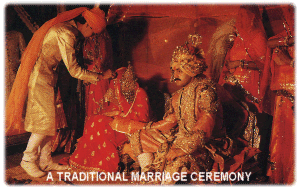


Hindu marriages are not entered into lightly and the decision is not made solely by the couple. Very much like the Muslim tradition, the proposal takes place at a gathering of the family, and is directed to the family elders. This gathering is very important in that it is used to determine the compatibility of the couple. The giving of a dowry has become a formality in modern marriages. It can include a number of things or it could just be the engagement ring.
The Hindu wedding ceremony comprises many different aspects and is field with many unique traditions. The bride, groom and guests gather at the bride's house. The day on which this takes place is determined by an astrologer or a family member, the venue is also chosen in this way and could be a marquee, hall or private home.
| Prokshanam | The groom is formally received at the entrance of the hall. |
| Varpuja | The groom is lead to the Mandap where he is received by his prospective parents; his right foot is cleansed as a mark of respect ( similar to the respect bestowed upon statues of Hindu gods) |
| Kanya Agaman | The bride is accompanied by her maternal uncles along the aisle. The priest recites holy verses, calling upon the whole world- devine and earthly animatesand inanimates- to bless those about to be married. |
| Kanya Puja | The brides right foot is cleansed by her mother as a mark of respect and to receive blessings from Goddess Lakshmi. |
| Kanya Daan | The brides parents solomnly declare that they are ready and willing to give away their daughter.The brides credentials to be a good wife are stated and the elders have confirmed her to be of a good upbringing and character. She has been bestowed with many clothes and jewellery. |
| Hastamelap | The brides parents place her right hand in that of the groom, a union of the couple that should remain unbroken. The priest recites three generations of relatives on both families and chants holy verses to cement the relationship. After the formal greeting of the two families, a short interval is called. |
| Mangal Fera | The couple then circle the fire four times and take the six vows each time touching a small stone with their right foot to signify their marriage to be rock solid! The groom leads the first three 'fera'. On the last 'fera' the bride leadsand they are deemed to be joined in matrimony. The sequence described demonstrates that while day to day affairs of domestic life are in charge of the wife, the husband is entrusted with the responsibility of the ultimate salvation of his spouse. |
| Sindoor | The bridegroom places a pinch of crimson powder (kum kum) in the middle of the parting in the brides hair to signify her lasting good luck and as a steadfast relationship. Red signifies auspiciousness and prosperity. This is the first act of the groom as the husband. |
| Saptapadee | The furniture under the canopy is rearranged and the
holy fire is lit in preparation for the principal wedding ceremony. The bride
and groom sit side by side and offer ghee to the sacred fire whilst the priest
chants holy blessings. The couple walk seven steps together under the guidance
of the priest reciting hymns to accomplish the principal duties as householders.
First step: Pure and nourishing food Second step: strength to develop physical, mental and spiritual powers Third step: Wealth and prosperity Fourth step: Knowledge, happiness and harmony by mutual love and trust Fifth step: Noble, virtuous and heroic children Sixth step: Self restraint and longevity Seventh step: Understanding.companionship, loyalty and unity |
| Aashirwad | The priest gives his blessings to the couple and asks the guests and relatives to bless them for a long life, happiness, peace and properity. The bride and groom also seek the blessings from family elders by touching their feet thereby lowering their heads below that of the elders. |
| Shantipath | The peace hymn is recited at the end of the above ceremonies. This involves praying that perfect peace and tranquility may reign throughout the Universal Creation. |
| Vidayi | The bride and groom, having fasted all day are then invited to a seated dinner. After this, the bride is given away to the groom and his family. This is an emotional time as the bride is seen to be severing all ties with her family. As the bride sits on the left side of the groom in the car, her brother comforts her and gives her blessings for the marriage. He says to her, 'We thank you for your presence with us for all these years and now wish you a safe journey not just for today but throughout life....'. |
Like all modern brides, Hindu women see their wedding day as the most important day of their lives. The traditional touches help to make their weddings special and unique. Once the couple is joined together they are both ready
for to face life's journey side by side. The wedding knot will later be untied in Meghpur in Saurashtra, India in front of the idol of Bhaiyabapa, a warrior par excellence of the Rathod clan.They are events that will live eternally in their memories.

